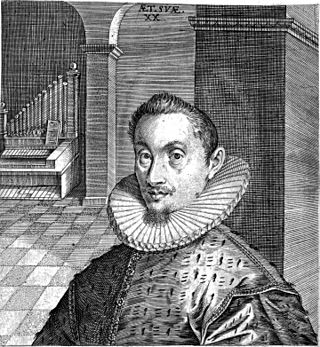
Hans Leo Hassler was a German composer and organist of the late Renaissance and early Baroque eras, elder brother of less known composer Jakob Hassler. He was born in Nürnberg and died in Frankfurt.
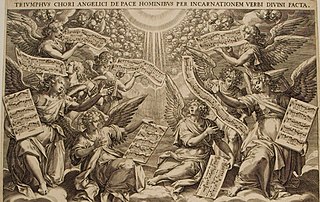
Andreas Pevernage or Andries Pevernage was a Flemish composer of the late Renaissance and a choirmaster in Bruges, Kortrijk, and Antwerp. He was one of a few composers from the Low Countries who remained in his native land throughout the turbulent period of religious conflict in the late 16th century. He was a skilled composer of chansons, motets and madrigals.
Peter Philips was an eminent English composer, organist, and Catholic priest exiled to Flanders. He was one of the greatest keyboard virtuosos of his time, and transcribed or arranged several Italian motets and madrigals by such composers as Lassus, Palestrina, and Giulio Caccini for his instruments. Some of his keyboard works are found in the Fitzwilliam Virginal Book. Philips also wrote many sacred choral works.
Orazio Benevoli or Benevolo, was a Franco-Italian composer of large scaled polychoral sacred choral works of the mid-Baroque era.
The year 1612 in music involved some significant events.

Johann Staden was a German Baroque organist and composer. He is best known for establishing the so-called Nuremberg School.
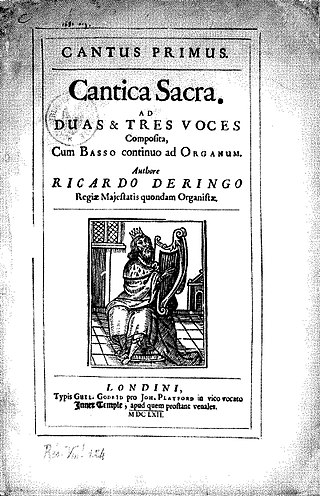
Richard Dering — also Deering, Dearing, Diringus, etc. — was an English Renaissance composer during the era of late Tudor music. He is noted for his pioneering use of compositional techniques which anticipated the advent of Baroque music in England. Some of his surviving choral works are part of the repertoire of Anglican church music today.
Pro Cantione Antiqua of London (PCA) is a British choral group which was founded in 1968 by tenor James Griffett, counter-tenor Paul Esswood, and conductor and producer Mark Brown. Their first concert was at St Bartholomew's, Smithfield with Brian Brockless conducting but, from an early stage, they were closely associated with conductor and musicologist Bruno Turner. Arguably, they were the leading British performers of a cappella music, especially early music, prior to the founding of the Tallis Scholars.
The Choir of Trinity College, Cambridge is a mixed choir whose primary function is to sing choral services in the Tudor chapel of Trinity College, Cambridge. In January 2011, Gramophone named the choir the fifth best choir in the world.
Jacob Regnart was a Flemish Renaissance composer. He spent most of his career in Austria and Bohemia, where he wrote both sacred and secular music.
Thomas Elsbeth was a German composer.

Catholic Marian music shares a trait with some other forms of Christian music in adding another emotional dimension to the process of veneration and in being used in various Marian ceremonies and feasts. Marian music is now an inherent element in many aspects of the veneration of the Blessed Virgin Mary in Catholic Mariology.
Tiburzio Massaino was an Italian composer.
Alexander Utendal was a Flemish composer.
Manfred Cordes is a German conductor of early music, musicologist and teacher. He is professor at the Hochschule für Künste Bremen and was its rector from 2007 to 2012.
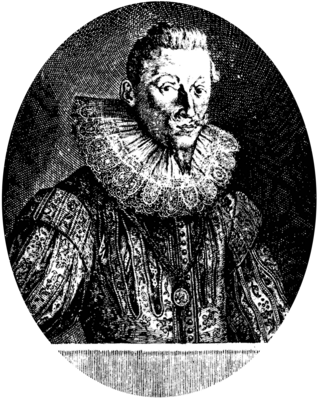
Cantiones sacrae, Op. 4, is a collection of forty pieces of vocal sacred music on Latin texts, composed by Heinrich Schütz and first published in 1625. The pieces have individual numbers 53 to 93 in the Schütz-Werke-Verzeichnis (SWV), the catalogue of his works. The general title Cantiones sacrae was common at the time and was used by many composers, including Palestrina, Byrd and Tallis and Hans Leo Hassler (1591).

The Missa tempore Quadragesimae, Klafsky 1:19, MH 553, is a mass without a Gloria by Michael Haydn. The work in D minor was written in 1794 in Salzburg, scored for a four-part choir and organ. It is suitable also for Advent.
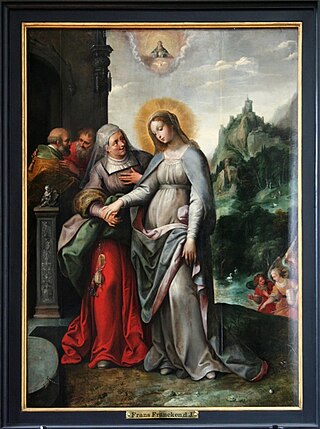
Übers Gebirg Maria geht is a sacred motet by the Renaissance composer and musician Johannes Eccard, who wrote it on a German text by Ludwig Helmbold in two stanzas. The first stanza is a rephrasing of the biblical story of the visit of Mary to Elisabeth, ending in Mary's song of praise known as the Magnificat. The second stanza speaks to present-day listeners, urging them to follow Mary's example and go over the mountains, be inspired, support each other, and sing the Magnificat.

The Oxford Camerata is an English chamber choir based in Oxford, England. The Camerata was founded in 1984 by conductor Jeremy Summerly and singers David Hurley and Henrietta Cowling and gave its first performance on 22 May of that year. The ensemble consists of a core membership of fifteen singers, though personnel size varies according to the demands of the repertoire. While the Camerata is known for performing primarily unaccompanied repertoire, it has also performed accompanied repertoire, employing the services of the Oxford Camerata Instrumental Ensemble and the Oxford Camerata Baroque Orchestra.

Verbum caro factum est is a sacred motet for six voices by Hans Leo Hassler. The Latin text is taken from the prologue to the Gospel of John. The voices are divided into two groups of three that sing antiphonally in the Venetian polychoral style. The motet is often performed for Christmas, in services, concerts and on recordings. Instruments can play along with the voices, and it has been arranged for instruments alone.










